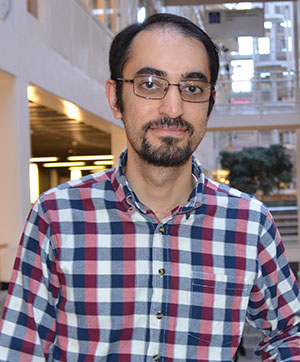Congratulations on your graduation PhD Hosein Attarzadeh
Congratulations on your graduation
Seyed Hosein Attarzadeh Niaki came to KTH School of Information and Communication Technology in 2006 for master studies in System-on-chip design. After performing his Master thesis in Switzerland and a short period of research in Singapore he came back to KTH Kista for doctoral studies. Now he has defended his PhD thesis "Managing the Complexity in Embedded and Cyber-Physical System Design".

Where are you from and where did you study before coming to KTH?
– I am from Tehran, the capital of Iran. I received my B.Sc. on Electrical Engineering from K.N.Toosi University of Technology in 2006. Thereafter I was admitted to the system-on-chip design Master's programme at KTH and graduated in 2008 after performing my thesis on reconfigurable hardwares at EPFL in Switzerland. Following a short period of research work at National University of Singapore, I started my doctoral studies at KTH School of ICT in the department of Electronic Systems.
What is your topic and why did you choose it?
– I work on modelling and design of embedded electronic systems. The topic of my PhD studies is the intersection of electronic hardware and computer science, which is a perfect match to my interests. Since the time I played with my Lego toys in childhood, I found the courage of building stuff — especially building them in the correct way — in myself. As soon as I was exposed to the world of computers and electronics in high school, I realized that I have found my way in the world of science and engineering. I was lucky enough to have the chance to pursue my studies and research in this direction so far.
Describe your topic in short.
– Embedded electronic systems are ubiquitous. We constantly interact with them and our life is influenced by them even if we are not aware of them. Our mobile phones, microwave ovens, smart cards, modern vehicles, and elevators are a few examples of systems which have embedded electronic systems. There is an increasing demand to include more functionality in such systems which makes designing them more challenging. My research involves proposing methods and tools to build more complex embedded systems in a correct and efficient way. This is of utmost importance in safety-critical areas such as medical devices, avionics, or public transportation where the faulty behavior of these systems might lead to a catastrophe. In our group, we develop a formal system modelling and design methodology called ForSyDe to address this challenge.
Tell us something about your results.
– As the result of close interaction with industrial companies in three different EU research projects, I have extended and implemented the ForSyDe modelling methodology on top of an industry-standard modelling language. This helps the designers to easily model and validate their systems early in the design flow and then apply automated analysis and synthesis methods on these models to realize the final product. Our industrial partners reported increased productivity by using our tools in their design flows. This tools is available with a permissive license via the ForSyDe web page . Further contributions are reported in my thesis .
What will the future bring for your research topic?
– The possibilities provided by the advance of manufacturing technology and the intension to lower the system cost, calls for sharing the same hardware chip to implement different functionalities of an embedded system, which makes their design even more challenging. In addition, new paradigms such as internet of things and cyber-physical systems have emerged which add new dimensions to the problem. These issues call for novel methods and tools to address them.
What are your future plans?
– I envision my future career as a researcher in academia. For the short term, I am going to stay at KTH and continue with what I have done so far. Although I have enjoyed the years that I have been at KTH as a student and researcher, it is time to look for further opportunities in other places. However, I am willing to keep in touch with the ForSyDe group and hopefully continue our collaboration.

